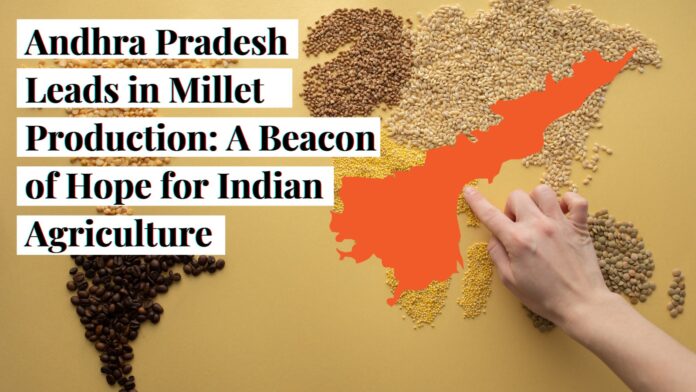India’s agriculture, known for paddy and wheat, saw a surge in millet farming. NABARD’s 2022-23 report praised Andhra Pradesh’s top millet yield of 2,363 kg/ha.
The realm of agriculture in India, often synonymous with green paddy fields and vast wheat plantations, received a boost in an often-underestimated sector: millet farming. The National Bank for Agriculture and Rural Development (NABARD) annual report for 2022-23 heralded Andhra Pradesh’s remarkable leadership in millet yield. With the state allocating 1.52 lakh hectares for millet cultivation, it reaped a whopping 3.6 lakh tonnes in 2022 alone. This intense farming venture yielded an outstanding 2,363 kilograms per hectare.
So, what does this mean for the Indian agricultural landscape and its legion of farmers?
Embracing Diversity in Crops:
Millet, often seen as a “poor man’s grain” in the past, is now being recognized for its nutritious value and sustainability in growth. With changing climate patterns and the unpredictability of monsoons, the need for crops that are both resilient and economically viable is paramount. Millets, being drought-resistant and hardy, fit the bill perfectly. Andhra Pradesh’s success story can be a role model for other states, showing that diversifying traditional farming practices can yield tangible results.
Future Opportunities for Farmers:
The success of Andhra Pradesh in millet production isn’t just an isolated event; it marks the beginning of a transformative journey for farmers across India.
1. Health and Nutrition Boom:
With the global emphasis on health and nutrition, millet is gaining traction as a superfood. Rich in fiber, proteins, and essential minerals, they cater to a growing segment that prefers nutritious grains over processed foods. This spells potential premium pricing and higher demand for millet in domestic and international markets.
2. Sustainable Farming Practices:
Millets require less water compared to many traditional crops, making them a sustainable choice, especially in regions with water scarcity. Their cultivation could mean more consistent yields for farmers, even in adverse weather conditions.
3. Government Support and Incentives:
Seeing the success and potential of crops like millet, the government might increase its support. This could manifest in the form of subsidies, training programs, or incentives to farmers who opt for millet cultivation, aiding in boosting their income levels.
4. Export Potential:
India, with its vast agricultural capabilities, can tap into the international market where the demand for organic and nutritious grains is on the rise. With the right marketing and quality checks, Indian millets can find their place on global shelves, further enhancing the profit margins for farmers.
5. Innovation in Agro-industry:
Success in millet farming can pave the way for innovations in the agro-industry. New machinery, farming techniques, and post-harvest technologies tailored for millet can emerge, making cultivation and processing more efficient.
6. Local Job Creation:
With increased cultivation and the potential establishment of processing units, there’s an opportunity for job creation in the local communities. This would not only boost the rural economy but also prevent the migration of the rural workforce to urban centers.
The rise of Andhra Pradesh as a leader in millet production is more than just a feather in its cap. It’s a clarion call for the rest of the nation to recognize the potential of diversifying traditional farming practices. As India stands on the brink of an agricultural revolution, millets and their promising future can guide the way, offering hope, sustainability, and prosperity to the diligent farmers of this vast nation.




